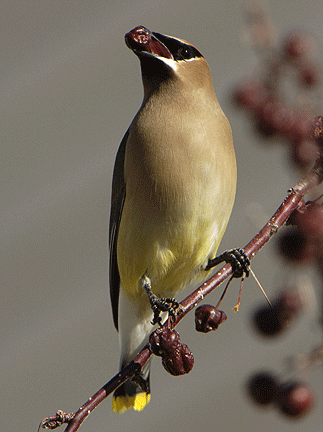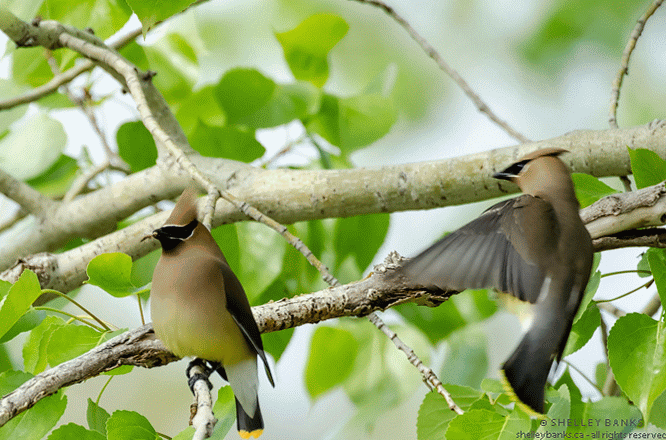Cedar Waxwing (Bombycilla cedrorum) General Biology:



APPEARANCE
The Cedar Waxing boasts a shiny silk-like collection of wing feathers ranging from
rusty brown to industrial grey. In addition, the golden yellow tip of the squared off tail
sets the bird apart during identification. Its overall plumage is complemented by the
slick reddish-brown crown and crisp, solid black eye line. On the tip of its wings, we
observe fluorescent red, “wax like” droplets set against the subtly grey background
plumage. The beak is short, sharp, and black, giving it prime ability to crack open
seeds while foraging for fruit. (Witmer et al., 2014)
On average, the cedar waxwing weighs about 32 g and is no more than 15.5 cm in
length. The Cedar Waxwing’s order is passeriformes while it belongs to the family
bombycillidae.

Cedar Waxwing
(https://www.allaboutbirds.org/guide/Cedar_Waxwing/lifehistory#at_nesting)

Cedar Waxwing Distribution
(https://www.sdakotabirds.com/species/maps/cedar_waxwing_map.htm)
SOCIAL BEHAVIOR
The Cedar Waxwing holds a dominant presence in southeastern Canada and
northeastern United States. It can be found year-round in most, if not all, of the
northeastern region of the United States.
Cedar Waxwings, are quite a social species as they will flock in large groups
throughout the year; however, winter seems to be the season during which Cedar
Waxwing flocks are the largest. In addition, this species tends to convene in small
groups at certain fruit crops throughout the breeding season to collect food. Often
times, the Cedar Waxwing joins the flock of another species called the Bohemian
Waxwing and vice versa. When it comes to nesting and nesting sites, the Cedar
Waxwing demonstrates aggressive behavior to certain species. This is interesting
because species such as: Hermit Thrush, American Goldfinch, Gray Catbird, House
Wren, Common Gackle, and American Redstart will receive aggressive behavior from
the Cedar Waxwing because of the threat of nest take over. However, species such as
the Eastern Phoebe, Black-capped Chickadee, Yellow Warbler, Red-eyed Vireo, and
Indigo Bunting do not receive aggressive behavior from the Cedar Waxwing. (Witmer et al., 2014)
Regarding predation, the following species are known predators of Cedar Waxwings:
Merlin, Sharp-skinned Hawk, Cooper’s Hawk, Common Grackles, Blue Jays, and
House Wrens. The way a Cedar Waxwing responds to predation is through an erect
posture, making itself seem “cryptic”. The waxwings will transition from elongated
flight formation to vertical line formation when pursued by a predator. In the case of
the Cooper’s Hawk, this tactic proved itself successful as the predator accelerated past
the flock of Cedar Waxwings. When a nest is disturbed, the male Cedar Waxwing will
deliver a seee disturbance call while perched in a “sentinel position” near the nest.
(Witmer et al., 2014)

Cedar Waxwing during predation: erect posture
(https://www.pinterest.com/pin/122582421077495779)
FORAGING AND HABITAT
Before diving into its foraging style, let’s consider the Cedar Waxwing’s habitat. This
bird prefers open woodlands, shrubby field, deciduous, coniferous, and other mixed
woodlands. Areas alongside streams are also preferable for this species. The given
habitat for the Cedar Waxwing pertains mostly to their diet, which includes the fruits
of shrubs and small trees. (Audobon, Guide to North American Birds)
As mentioned earlier, the Cedar Waxwing possesses a short and sharp beak that helps
it to forage for seeds, fruit, and berries. The Cedar Waxwing is quite unique in that the
bird can sustain itself on fruit alone for months at a time, making it known as a
frugivore. While holding a branch with its claws, the bird will pluck the fruit off for
consumption; however, the bird will also hover for some time to pluck a berry off a
tree. Their main diet consists of fleshy fruits and insects as well. When foraging for
insects, fruit, or even flowers, the Cedar Waxwing forages in fruiting trees and shrubs
located in either towns or suburbs. During the summer, they enjoy strawberries,
mulberries, dogwood, and raspberries. In the winter season, the bird’s diet consists
almost completely of fruit and its favorite berry tends to be the cedar berries during
the winter. In the spring, the bird’s diet becomes mostly flowers and insects as fruit
crops begin to die out across their habitat. (Witmer et al., 2014)
When a gut analysis was performed on 212 Cedar Waxwings from the northeastern
U.S, researchers found that 84% of their diet consisted of fruit, 12% of insect prey, and
4% of flowers; this was a representation of the annual diet. From fall to winter, fruit
tends to be 100% of the bird’s diet. Similarly, Cedar Waxwings in the wild choose to
consume sugary fruits such as cherries, crab apples, hawthorn fruits and cedar
berries. In this respect, the Cedar Waxwing can sustain itself with fruit for at least 2
months and performs quite well while consuming sugary, low-protein fruits. (Witmer et al., 2014)

Cedar Waxwing eating berries
(https://fineartamerica.com/featured/1-cedar-waxwing-eating-serviceberry-doris-dumrauf.html)
BREEDING BEHAVIOR
As far as breeding is concerned, Cedar Waxwings typically start the egg-laying process
from early June through early August. This breeding behavior is correlated with the
ripening of the fruits Cedar Waxwings eat in the early-to-late summer months. The
male usually initiates courtship-hopping with pecking of the beak and the female
must reciprocate for success. (Witmer et al., 2014)
Usually, the female waxwing will perform most of the nesting during the first nesting
attempt of the mating season. She takes materials such as blossoms, string, horsehair,
grasses, twigs, and other natural materials and compiles a “cup” formation. By the end,
a waxwing may have performed some 2500 trips before construction is over. Females
normally make the ultimate decision of where the nest will be located, and it seems the
waxwing prefers the edge of wooded areas or isolated trees/shrubs. More specifically,
they select the fork of a branch for added stability.

Cedar Waxwing perched next to its nest
(http://wildbirdsunlimited.typepad.com/the_zen_birdfeeder/2013/07/cedar-waxwing-nest.html)
(https://www.youtube.com/watch?v=0mS4HS1v1wM)
CITATIONS
